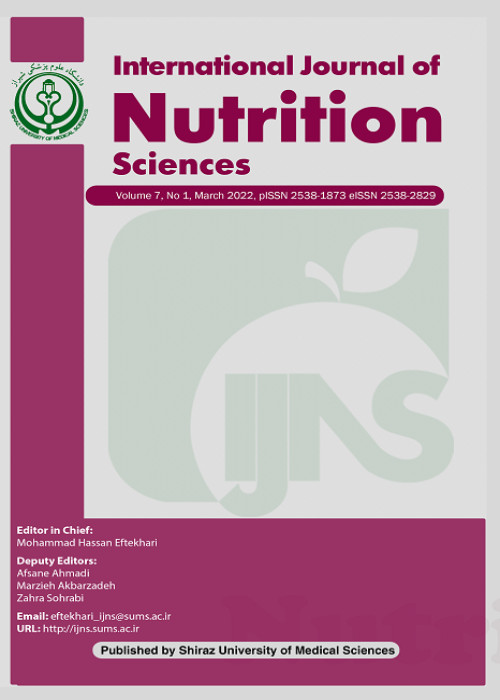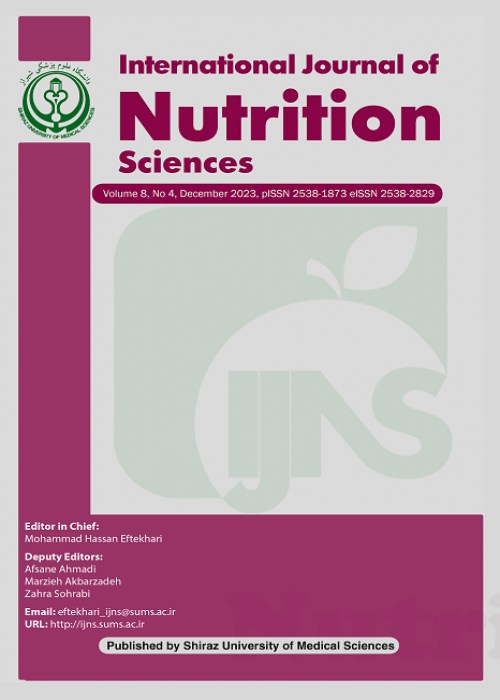فهرست مطالب

International Journal of Nutrition Sciences
Volume:8 Issue: 1, Mar 2023
- تاریخ انتشار: 1401/12/16
- تعداد عناوین: 8
-
-
Pages 1-8
Chronic kidney disease (CKD) is a clinical condition that can end in endstage renal disease (ESRD) and needs dialysis or a kidney transplant. Hypertension, diabetes, obesity, and cardiovascular risk factors are the main contributing factors to the CKD process. One of the factors with exogenous and endogenous sources affecting the CKD progression or prognosis and its complications is the accumulation of advanced glycosylation end products (AGEs) through the glycosylation of proteins, lipids, or nucleic acids or by dietary sources. AGEs accumulationcan adversely affect the long-term complications of diabetic patient such as nephropathy or retinopathy, especially in those with type 2 diabetes. These compounds can affect cardiovascular health by inducing cardiomyopathy and congestive heart failure. Dialysis patients are among those with higher oxidative stress and lipid peroxidation which can affect the levels of AGEs in these patients. Lower clearance or excretion of the AGEs through kidneys and higher dietary absorption can cause higher levels of AGEs in this population. Higher AGEs are accompanied byhigher rates of CVD, connective tissue disorders, mortality and lower quality of life in CKD patients. Dietary modifications are considered one of the main factors affecting the levels of AGEs in CKD patients which can improve their prognosis and complications even in the absence of diabetes. The ways of cooking and the ingredients focusing on reducing the temperature, cooking time, moist heat, and using acidic ingredients such as lemon juice or using anti-AGE compounds are recommended for reducing AGEs formation in foods.
Keywords: Glycosylation, Renal Failure, Food processing, Complications -
Pages 9-19
Diet and lifestyle can greatly affect health and susceptibility to diseases. The nutritional needs of stem cells and their role in quantity and quality of stem cells is of great importance for cell renewal and healing process in injured tissues, because nutrients have an important role in stem cell physiology as many nutrient-derived metabolites released during the catabolic process can induce chromatin reshaping, epigenetic modifications and gene expression modulation. It seems that the maintenance of stem cell populations for tissue renewal and physiological restoration can be considered as one of hallmarks of health status. Based on the role of stem cell in tissue renewal and regeneration, establishing the nutrition requirements in diseases, during trauma recovery, and in aging process should come into consideration for establishing nutrient recommendations to decrease the prevalence of diseases and to advance the understanding of the biological pathways and mechanisms that connect stem cells nutrition requirements with diseases and aging.
Keywords: Diet, Nutrition, Mesenchymal stem cell, Function -
Pages 20-26BackgroundOne of the concurrent illnesses linked with COVID-19 is Diabetes mellitus (DM). DM patients must follow a diet plan and engage in physical exercise to reduce illness complications and enhance immunity during COVID-19 pandemic. This study aimed to determine relationship of carbohydrates, vitamin D, zinc consumption and physicalactivity with fasting blood glucose levels in Type 2 Diabetes Mellitus (T2DM) patients during COVID-19 pandemic.Methodsa cross-sectional study was undertaken in three health centers of Bantul Health Center, Bambanglipuro Health Center, and Pajangan Health Center. Members of the Chronic Disease Management Program (PROLANIS) were among the responders with T2DM. Semi Quantitative Food Frequency Questionnaire (SQ-FFQ) and Short Form International Physical Activity Questionnaire (SF-IPAQ) were completed to measure the degree of physical activity to figure out eating habits. Fasting blood sugar and Glucose Oxidase-Peroxidase Aminoantipyrine blood samples (GOD-PAP) were also determined.ResultsThe consumption of carbohydrates and physical activity were both linked to fasting blood glucose levels (p<0.05). T2DM patients with low vitamin D consumption habits had 1.3 times greater risk of experiencing abnormal fasting blood glucose level (OR=1.292). Carbohydrate consumption, vitamin D, zinc, and physical activity had contribution as much as 16.2% to affect the occurrence of abnormal fasting blood glucose level.ConclusionAs in T2DM patients with low vitamin D consumption habits, a higher risk of experiencing abnormal fasting blood glucose level was noticed. So health planning issues are needed for vitamin D consumption in T2DM patients during COVID-19 pandemic.Keywords: Carbohydrates, Vitamin D, zinc, Physical Activity, diabetes mellitus
-
Pages 27-35BackgroundThere are rising public health concerns due to diseases associated with increasing trends of overweight and obesity with significant adverse health, psychological and socioeconomic consequences. The objective of this study was to determine the prevalence and factors associated with overweight and obesity among the staff of multinational companies in Rivers State, Nigeria.MethodsA cross-sectional and analytical study was conducted among the staff of two multinational companies. A multi-stage sampling technique was employed to recruit 296 respondents from the companies. Respondents’ information was obtained using a semi-structured questionnaire, their weight and height were measured using standard procedures and Body Mass Index (BMI) was determined using WHO classification.ResultsMale respondents were 59.5% and 40.5% were female. The prevalence of overweight and obesity was 43.6% and 15.2%, respectively. Many (58.1%) of the respondents were physically inactive and those who sometimes - always engaged in exercise were less likely to be obese. Overweight and obesity were found to be significantly related to female sex (p<0.05), increasing age (p<0.001), currently married (p<0.001), high level of education (p<0.05), and increased monthly income (p<0.001).ConclusionHigh prevalence of overweight and obesity was observed among the respondents. Therefore, top management of companies especially in the study area should implement regular, and workstation interventions to address rising BMI among their staff, and awareness promoting a healthy lifestyle, physical activity, and avoiding risky behaviors should be implemented.Keywords: Body mass index, Physical inactivity, Overweight, Obesity, Lifestyle
-
Pages 36-46BackgroundThe rise in hyperlipidemia cases is still alarming, worldwide. This study determined the effect of zinc oxide nanoparticles (ZnO NPs) on hyperlipidemia in experimental rats.MethodsRats were assigned to six equal groups of five rats. Hyperlipidemia was induced by 7 days intraperitoneal injection of Triton X-100. Group 1 (Sham) received standard diet, Group 2 (Negative control) received 100 mg/kg Triton X-100, Group 3 (Standard) received 100 mg/ kg Triton X-100 and 10 mg/kg atorvastatin, Group 4 received 100 mg/kg Triton X-100 and 100 μg/kg ZnO NPs, Group 5 received 100 mg/kg Triton X-100 and 300 μg/kg ZnO NPs and Group 6 received 100 mg/kg Triton X-100 and 500 μg/kg ZnO NPs, orally.ResultsZnO NPs displayed a light crystalline phase with fine peaks of ZnO wurtzite structure. ZnO showed lower antioxidant activity at concentrations of 60 and 100 μg/mL. A significant decrease in serum total cholesterol (TC), triglycerides (TG), low density lipoproteins (LDL) levels and atherogenic index with a significant increase in high densitylipoproteins (HDL) level were noticed in groups received ZnO NPs in a dose dependent manner. There was a significant decrease in alanine transaminase (ALT) level, with no significant difference in aspartate transaminase (AST) and alkaline phosphatase (ALP) levels at the highest dose. There was a significant decrease in serum antioxidant enzymes and cardiovascular biomarkers. Histologically, there was a healing in cardiac tissue following administration of ZnO NPs.ConclusionZnO NPs were shown to have antihyperlipidemic and cardiovascular protective effects by regulating lipid metabolism-related biochemical parameters.Keywords: Allium cepa, Zinc oxide nanoparticles, Triton X-100, Hyperlipidemia, Rat
-
Pages 47-56BackgroundThe central melanocortin system is among those that plays a key role in the homeostatic regulation of energy balance and eating disorders. This study investigated the effect of melanocortin 4 receptor (MC4R) agonist setmelanotide (RM-493) on changes in metabolic and cognitive functions.MethodsThirty two male Sprague-Dawley rats were divided into 4 groups including those fed with standard laboratory food and given phosphate buffered saline (PBS, ND group); fed with western-type diet and given PBS (WD group); fed with standard laboratory food and given RM-493 (RM-493 group); and fed with western-type diet and RM-493(WD+RM-493 group). After injection with PBS and RM-493 injections for 5 days, they were followed by elevated plus maze test and a novel object recognition test.ResultsNutrition with western-type diet resulted in an increase in serum cholesterol, high-density lipoprotein (HDL) and low-density lipoprotein (LDL) levels, respectively, and RM-493 treatment decreased these values. Proopiomelanocortin (POMC), MC4R and brain-derived neurotrophic factor (BDNF) expressions increased in groups fed with western-type diet and RM-493. Treatment with RM-493 in ND group increased the residence time in the open arm. In WD group, CA3 region of the hippocampus revealed edema in stratum lucidum layer and degeneration in the pyramidal neurons unlike the WD+RM-493 group.ConclusionPOMC-mediated pathway was activated as a result of an increase in body fat caused by a western-type diet. RM-493 had alleviating effects on brain damages caused by a western-type diet and could improve cognitive functions.Keywords: Western diet, Cognitive Functions, Brain, MC4R, RM-493
-
Pages 57-62BackgroundDry noodles are products made from wheat flour which are dried to a maximum moisture content of 10%. This study investigated on analysis preference between dried catfish noodles and yellow flour and determined the protein and water content.MethodsIn an experimental completely randomized design using 3 treatments with different pumpkin flour substitutions, namely 5%, 7.5% and 10%, analysis preference between dried catfish noodles andyellow flour and a protein and water content analysis were undertaken according to the terms of the dry noodle quality requirements (SNI 8217-2015). The appearance, color, aroma, texture, flavor, overall appearance were also compared between dried catfish noodles and yellow flour.ResultsThe 10% pumpkin flour substitution showed the highest value for appearance, color, aroma, texture and overall acceptance; whereas the flavor was dominated by 5% pumpkin flour substitution. The test for the highest protein content and the lowest water content was in 7.5% pumpkin flour substitution. The higher the water content, the lower was the protein content. Based on the proximate test, protein content of dried catfish noodles ranged 12.95-15.47%; and the water content of dried catfish noodles ranged 9.49-12.60%.ConclusionThe 5% pumpkin flour substitution was preferably organoleptic, but the best water content was in 7.5% pumpkin flour substitution in accordance with the quality requirements for dry noodles (SNI 8217-2015). It is necessary to test acceptability of the product with variations in noodle processing techniques and differences in cooking recipes. Therefore, these finding can help the health authorities in nutritional plans.Keywords: Catfish, Dried Noodles, Pumpkin Flour, Preference, Indonesia
-
Pages 63-70Background
Rice milk is one of the traditional foods in Khuzestan province. Due to the combination of milk and rice, this product plays a major role as a diet for children under two years old and also as a diet for adults. Heavy metals represent a special group of food contaminants and exposure to heavy metals was shown to be directly related to progression of diseases. This study was conducted to determine the concentrations of some heavy metals in rice milk to evaluate whether the concentrations of these elements correspond to the permissible levels of toxic elements in milk and rice in Ahvaz, Khuzestan Province, Iran.
MethodsTotally, 50 rice milk samples (25 samples from East Ahvaz and 25 samples from West Ahvaz) were collected. The heavy metals in all samples were evaluated using quantified diffuse spectroscopy (OES) or mass spectrometry (MS).
ResultsThe mean concentration of the arsenic and lead was above the permissible limit. The average nickel and cadmium concentrations in the samples were below the allowable limit values and no mercury was detected in all samples.
ConclusionThe study results showed that consumption of rice milk did not pose a direct and serious threat to the health of consumers. Future studies and continuous monitoring are necessary to assess the content of heavy metals and the risk of their consumption to the consumer of the rice milk.
Keywords: Heavy metal, Rice milk, Health, Iran


